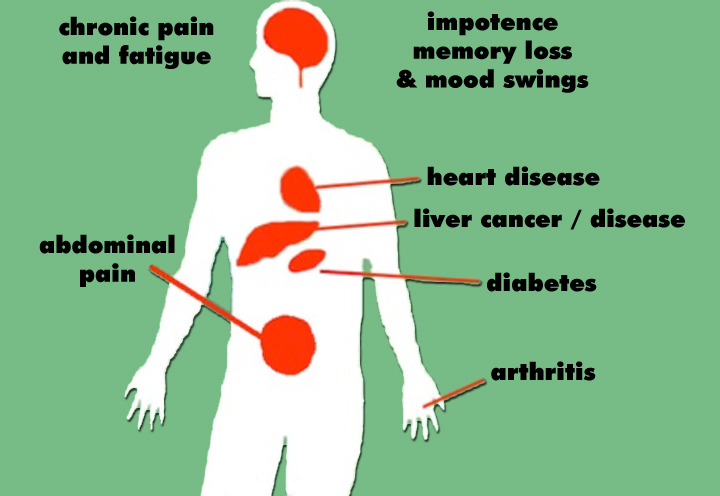Hemochromatosis Treatment
Hemochromatosis is a condition that causes the body to absorb too much iron from the food that is eaten. This excess iron is then stored in the organs, especially the heart, the liver and the pancreas. This can lead to severe life-threatening conditions like diabetes, liver disease and heart issues. The most common type of… Read More
Top Doctors For Hemochromatosis Treatment Treatments
Top Hospitals For Hemochromatosis Treatment Treatments
Hemochromatosis Treatment
Hemochromatosis is a condition that causes the body to absorb too much iron from the food that is eaten. This excess iron is then stored in the organs, especially the heart, the liver and the pancreas. This can lead to severe life-threatening conditions like diabetes, liver disease and heart issues. The most common type of this condition is caused by a gene change that is passed down through families. Only a few people who have the genes ever develop the symptoms, and they usually develop in their midlife.
What causes the condition?

There are two types of hemochromatosis, and they each have different causes. The most common cause of the condition is an inherited genetic change; it is called primary hemochromatosis. It can also be referred to as classical or hereditary hemochromatosis. The issue originates with problems with the DNA that come from both parents and causes the body to absorb too much iron. In secondary hemochromatosis, medical treatment or other medical conditions cause iron overload. Some of the causes of the secondary hemochromatosis include:
- Blood transfusions
- Iron injections or pills
- Kidney dialysis over a long period
- Liver diseases like hepatitis C infection or fatty liver disease
What are the risk factors of the condition?
The inherited form of hemochromatosis is usually more common in white people with Northern European ancestry. It is less common in African-American, Hispanic, Indian, or Asian descent. Men also have hemochromatosis earlier and more than women. Women store less iron than men, and they lose iron during menstruation and pregnancy. The condition is also more common in older people because iron toxicity takes years to develop. Other risk factors that may increase the chances of developing the disease are alcohol abuse and a family history of liver disease, arthritis, erectile dysfunction, diabetes, heart attack, etc.
What are the symptoms seen in the condition?

Early symptoms of the condition are often mistaken for those of other common conditions. Symptoms seen may include:
- Heart failure
- Joint pain
- Fatigue
- Weakness
- Diabetes
- Loss of sex drive
- Impotence
- Liver failure
- Bronzing of skin
- Memory fog
- Irregular heartbeat
- Pain in the knuckles of the middle and pointer fingers
- Stomach pain
While the most common type of hemochromatosis is present at birth, the symptoms usually do not appear until later in life, usually after the age of 40 in men and 60 in women. The symptoms will appear in women after menopause when they no longer lose iron with pregnancy and menstruation.
What are the complications of hemochromatosis?
Untreated hemochromatosis can lead to some complications that will usually affect the joints and organs where the excess iron is stored like the liver, heart and pancreas. Some of the complications include:
- Liver problems – Cirrhosis is one of the major complications that may arise and this predisposes the liver to other diseases like liver cancer and other life-threatening complications
- Diabetes – This is usually elicited by the damage to the pancreas.
- Heart issues – the excess iron in the heart affects its ability to circulate enough blood for the body. This is referred to as congestive heart failure. The condition can also cause abnormal heart rhythms.
- Reproductive issues – Excess iron can lead to erectile dysfunction and the loss of libido in men. In women, it can lead to the absence of the menstrual cycle.
- Skin colour changes – The deposits of iron in the skin cell can make the skin appear bronze or greyish.
How is the condition diagnosed?
The doctor will take the medical history of the patient and ask about the symptoms that they are experiencing. They will also ask important questions about the family history of the patient and conduct a physical examination. Following the preliminary examinations, they may then order the following tests:
- Blood tests that will measure the amount of iron in the blood and the organs
- Genetic testing to determine if the patient has the inherited form of hemochromatosis
- Liver biopsy where a small piece of liver tissue is removed and examined under a microscopic
- MRI that will take a detailed picture of the patient’s organs
How is hemochromatosis treated?
The symptoms experienced in the condition can be eased by diet changes and some other treatments. They can also greatly reduce or delay any further damage that can occur in the organs. Some of the hemochromatosis treatment methods that can be employed include:
- Changes to the diet – the patient will be instructed by their healthcare provider to avoid any iron supplements. The patient would also avoid excess vitamin C and other food that may have too much iron. They will also be advised to quit any liver-damaging habit like drinking.
- Iron chelation therapy – This therapy uses medication to remove extra iron from the body. The medication can be administered orally or through injection by the healthcare provider.
- Therapeutic phlebotomy – This procedure uses a needle and tube to remove blood and the iron it contains from the body. The treatment is usually frequently repeated and regular blood tests that will measure the iron levels are carried out.

If there is an underlying condition that is causing hemochromatosis, it would need to be handled, and the symptomatic treatment of the condition will have to be done. In the case that the necessary treatment cannot be done in the patient’s country, overseas medical treatment may be recommended. This is usually offered by medical health tourism agencies or meditour agencies. This can be seen as a form of health or medical tourism.
Is there any way to prevent hemochromatosis?
The condition cannot be prevented, but the control of iron levels can help. The complications can also be prevented by identifying the condition early and treating it.
What is the outlook of the condition?
The outlook of the condition will usually depend on the timing of the diagnosis and the subsequent treatment. If not handled early enough, severe hemochromatosis can cause serious issues. These complications can include organ damage and can be fatal. However, early detection and treatment ensure the patient can live a normal and healthy life. In some cases, the organ damage can also be reversed.









































